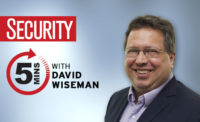5 minutes with Tim Sulzer - The rise of gun violence and physical security technology

In today's ever changing environment, no organization and enterprise is immune from violence. Whether it is a church, movie theater, mall, or healthcare setting the need to plan for an act of violence, including active shooter events, is of paramount importance.
And while public safety situational awareness and vigilance is an absolute must in our modern world, much thought has been given to how to develop plans, procedures, training and technology to stop these acts of violence.
Here, we talk to Tim Sulzer, Chief Technology Officer (CTO) of ZeroEyes, about how physical security technology has evolved over the years to help make a difference in situations involving an active shooter or to reduce workplace and gun violence in various settings.
Security magazine: What is your title and background, and what are your responsibilities?
Sulzer: I am the CTO and cofounder of ZeroEyes, an artificial intelligence (AI) weapons detection platform. In my role, I develop ZeroEyes’ technical roadmap and vision, ensure that we are continuously improving our machine learning algorithms in detecting visible guns to stop violent threats, and oversee our team of developers, engineers and other resources to align with our business goals. Prior to co-founding ZeroEyes, I was a multiple-time founder and startup advisor, and had experience developing various AI and computer vision-based solutions, including building a computer vision product to detect wildlife.
Security magazine: Let’s discuss the rise of physical security technology. How have physical security technologies evolved within the last 15 years?
Sulzer: Technological advancements in physical security have increased in leaps and bounds over the last 15 years. Unfortunately, the demand for physical security solutions can be correlated to the exponential rise in violent threats - including mass shooting tragedies - which continue to increase in both number and severity. It’s a sobering reality that this year the U.S. has experienced a surge in gun violence, and such physical threats are an all-too-common occurrence across the country.
Besides improvements in the quality of IP cameras, we’re seeing continual innovations and investments in a slew of technologies, including automated sensors, smart lighting, smart locks and keys, ID badging, emergency notification solutions and facial recognition. AI in particular has seen a significant impact in demand by organizations looking to leverage machine learning algorithms to quickly and accurately detect visible threats and take immediate action before any attacks occur. While even a few years ago there was a high degree of skepticism in deploying AI-based solutions due to potentially high rates of false positives (based on lighting, training the algorithm, etc), AI in particular has become more readily implemented and integrated into existing IP cameras.
Security magazine: Gun violence has continued to escalate in the number and severity of threats, particularly in the last decade. What has that meant for how school campuses, commercial buildings and government sites have needed to rethink and improve their security protocols?
Sulzer: For Chief Security Officers, Chief Risk Officers, security personnel and other physical security decision makers, the approach to securing buildings, campuses and government sites needs to be a multitiered approach involving people, processes and technologies and how they interplay with each other.
Certainly, there’s been a level of security awareness and investments that would have been unheard of a decade ago. On school campuses, for example, we’re hearing from school administrators that they are becoming more knowledgeable about safety and security innovations,as this is a top priority, despite this being completely separate to their areas of expertise. It’s our job, however, as physical security technologists and innovators, to provide the underlying solutions that offer a duty of care to customers, but fundamentally detect and stop violent threats before they occur.
Security magazine: To what extent has the COVID-19 pandemic added to the challenges of detecting and preventing active threats?
Sulzer: At the onset of the pandemic as buildings were closed, this did delay pilots and installations we had scheduled. However, with gun violence continuing to take place in cities all across the U.S., in many instances this has actually hastened the push by security-minded professionals to assess their security protocols, and find ways to enhance them with the right processes, solutions and resources.
As many buildings gradually start to reopen since the pandemic, companies are increasingly looking past the COVID shutdown, and are taking advantage of this time with reduced onsite employees to upgrade infrastructure and pilot innovative new technologies.
Security magazine: What type of security resources and systems are companies currently investing in, and how do these installations play a component in their security strategies?
Sulzer: Based on our conversations with partners and customers, we’re seeing a number of technologies being assessed or implemented, which include access control, gunshot detection, AI and other analytics (including mask detecting AI), and other cloud services focused on providing greater flexibility and lower long-term operational and maintenance costs.
For any physical security-minded organization, these technologies enhance situational awareness and extend the abilities of their team. These solutions should all be focused on providing security personnel and first responders with the real-time information needed to keep people safe.
Security magazine: What advice do you have for security teams, and/or those in charge of putting policies in place to safeguard physical sites from threats?
Sulzer: Firstly, a multitiered security approach should be centered around your technology infrastructure. The better your technology stack, the less blindspots you have and the more effective your team is. Whether it’s by installing IP cameras, access control and locks that operate inside and outside a building in high traffic areas, to increasing sensor density or incorporating proactive AI solutions, technology can inform your policy decisions and be a force multiplier for an organization - particularly as people continue to work remotely and resources are constrained.
Secondly, you should consider embracing cloud services with easy-to-upgrade edge sensors and infrastructure. The benefits of the cloud include greater flexibility, a wealth of integrations, and a cost-effective model that can serve as the backbone to your security environment.
Finally, it’s important to optimize your networks for throughput and security. Don’t leave performance on the table because of a component bottleneck, by doing things like continuing to assess vendors so that they are not a weak point in your network, as well as regularly testing your system and tweaking camera settings for best performance.
Looking for a reprint of this article?
From high-res PDFs to custom plaques, order your copy today!





